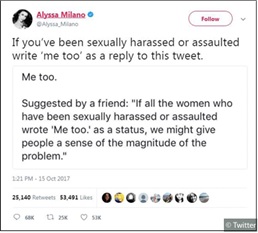The contemporary times have witnessed a ‘digital turn’ in civilisations across the world, with an increased accessibility to new technological innovations. The use of digital technologies and social media platforms as both a space as well a medium for social resistance have become commonplace. Such digital platforms enable individuals to network with one another, diminishing both distance and time, through the creation of dialogue and organisation of a diverse, but virtual human collective. The “Me Too” movement, which remains a classic case of digital activism, was conceived way back in the year 2006, by the social activist Tarana Burke, to promote the idea of “empowerment through empathy” among women who had been subjected sexual assault and harassment. Little had she known that 11 years later the #MeToo hashtag would become such a sensation. This hashtag movement was relaunched by the actor, Alyssa Milano, in October 2012 following an instance of sexual abuse in the hands of the Hollywood producer Harvey Weinstein. Alyssa’s tweet received an overwhelming response. “Facebook said that within 24 hours, 4.7 million people around the world engaged in the #MeToo conversation, with over 12m posts, comments, and reactions” (The Guardian, 2017). The #MeToo from hereon, not only became a rallying cry against sexual violence and assault, but also against prevailing conditions of contemporary patriarchy, sexism and misogyny. The robustness of this digital movement encompassed its magnitude, along with the global social upheaval it had been successful in creating. It is interesting to note in this instance how the medium becomes the message. What is further interesting to what it means for medium to become the message. This is not to say that the channel supersedes the content, thereby rendering the content inconsequential.
IMAGE SOURCE: HTTPS://WWW.DIGGITMAGAZINE.COM/ ACADEMIC-PAPERS/LANGUAGE-DIGITAL-ACTIVISM- EXPLORING-PERFORMATIVE-FUNCTIONS-METOO-TWEETS
The ‘message’ here refers not to the content, but rather the ‘change of scale or pace or pattern’ that such content induces in the social milieu. Medium on the other hand is to be simply understood as that which is an ‘extension of ourselves’, and from which a change emerges. The message therefore becomes the effect, i.e., a change in inter-personal dynamics or public attitude, of the medium. “This is merely to say that the personal and social consequences of any medium – that is, of any extension of ourselves – result from the new scale that is introduced into our affairs by each extension of ourselves, or by any new technology” (McLuhan, 2001). In this instance, the digital feminist activism becomes the medium. It is an extension of the individual self by acting as the means for the sharing and mapping of personal experiences and engaging in the ‘calling-out’ on the offenders. Informal digital networks become active agencies in inducing awareness, producing solidarities and the formulation of intervention i.e., the message.
Personal stories began pouring in from women in all industries across the world. It enabled the creation of a larger feminist consciousness, thereby allowing for the broader narrative to travel beyond that of an isolated instance to one of being a social and cultural crisis. It highlighted the unequal power distribution that has, since time immemorial, been normalised within the societal framework, thereby preventing countless victims from speaking up about sexual misconduct. The #MeToo campaign becomes crucial in positing that the personal is political, and enabled the representation of ‘personal troubles’ as an essential structural social problem. Feminism becomes both a personal and political imperative, at the intersections of biography and history.
IMAGE SOURCE: HTTPS://MEDIUM.COM/@DISQUIET_FEM/THE-PERSONAL-IS-POLITICAL-WHY-RECOGNIZING- NON-STATE-TORTURE-IS-A-WOMENS-RIGHTS-ISSUE-1A708DDA8B25
“The themes of global reach, speed, immediacy, dialogue, visibility, engagement, contact, connection, collectivity and shared understanding all emerged as important for participants” (Mendes, 2018). Women across the world felt empowered in being understood, through the public acknowledgement of the injustice done on them and validation they received from this virtual community, as compared to reporting the perpetration of sexual misconduct. The nature of such support though impersonal, sometimes has the potential of providing far more strength and comfort than what people in our immediate social milieu may be able to provide. In creating a community though instances of shared experiences, the culture of ‘sympathy’ is replaced by one of ‘empathy’. The ability to ‘relate with’, and to be ‘relatable’ diminishes the much detested dimension of ‘pity’. Digital campaigns of such nature makes visible the rotting core of our social structure. By facilitating the understanding of sexual violence as a broader structural problem, rather than as disparate individual experiences, it encourages a re-evaluation of the existing and taken for granted gendered social norms, and becomes a clarion call for debunking the ‘normal’.
References:
McLuhan, Marshall. “The Medium Is the Message.” Understanding Media. Routledge, 2001. Print.
Mills, C. Wright. “The Promise”.The Sociological Imagination. Oxford University Press, 2000.
“#MeToo: How a Hashtag Became a Rallying Cry against Sexual Harassment.” Google, www.google.com/amp/s/amp.theguardian.com/world/2017/oct/20/women-worldwide-use- hashtag-metoo-against-sexual-harassment.
Brockes, Emma. “#MeToo Founder Tarana Burke: ‘You Have to Use Your Privilege to Serve Other People’.” The Guardian, Guardian News and Media, 15 Jan. 2018, www.theguardian.com/ world/2018/jan/15/me-too-founder-tarana-burke-women-sexual-assault.
Laan, Nadine Van Der. June 2018.
Ma, Xiaohe. “PPT.” Mendes, Kaitlynn, et al. “#MeToo and the Promise and Pitfalls of Challenging Rape Culture through Digital Feminist Activism.” European Journal of Women Studies, vol. 25, no. 2, 2018, pp. 236–246., doi:10.1177/1350506818765318.
Wood, Marissa K., et al. “Language in Digital Activism: Exploring the Performative Functions of #MeToo Tweets.” Diggit Magazine, 1 Nov. 2018, www.diggitmagazine.com/academic-papers/language-digital-activism-exploring-performative-functions-metoo-tweets.
Federman, M..” What is the Meaning of the Medium is the Message?”. 23 July, 2004. http:// individual.utoronto.ca/markfederman/article_mediumisthemessage.htm .





Recent Comments